Evolutionary origins of the eukaryotic shikimate pathway: gene fusions, horizontal gene transfer, and endosymbiotic replacements
- PMID: 16963634
- PMCID: PMC1563581
- DOI: 10.1128/EC.00106-06
Evolutionary origins of the eukaryotic shikimate pathway: gene fusions, horizontal gene transfer, and endosymbiotic replacements
Abstract
Currently the shikimate pathway is reported as a metabolic feature of prokaryotes, ascomycete fungi, apicomplexans, and plants. The plant shikimate pathway enzymes have similarities to prokaryote homologues and are largely active in chloroplasts, suggesting ancestry from the plastid progenitor genome. Toxoplasma gondii, which also possesses an alga-derived plastid organelle, encodes a shikimate pathway with similarities to ascomycete genes, including a five-enzyme pentafunctional arom. These data suggests that the shikimate pathway and the pentafunctional arom either had an ancient origin in the eukaryotes or was conveyed by eukaryote-to-eukaryote horizontal gene transfer (HGT). We expand sampling and analyses of the shikimate pathway genes to include the oomycetes, ciliates, diatoms, basidiomycetes, zygomycetes, and the green and red algae. Sequencing of cDNA from Tetrahymena thermophila confirmed the presence of a pentafused arom, as in fungi and T. gondii. Phylogenies and taxon distribution suggest that the arom gene fusion event may be an ancient eukaryotic innovation. Conversely, the Plantae lineage (represented here by both Viridaeplantae and the red algae) acquired different prokaryotic genes for all seven steps of the shikimate pathway. Two of the phylogenies suggest a derivation of the Plantae genes from the cyanobacterial plastid progenitor genome, but if the full Plantae pathway was originally of cyanobacterial origin, then the five other shikimate pathway genes were obtained from a minimum of two other eubacterial genomes. Thus, the phylogenies demonstrate both separate HGTs and shared derived HGTs within the Plantae clade either by primary HGT transfer or secondarily via the plastid progenitor genome. The shared derived characters support the holophyly of the Plantae lineage and a single ancestral primary plastid endosymbiosis. Our analyses also pinpoints a minimum of 50 gene/domain loss events, demonstrating that loss and replacement events have been an important process in eukaryote genome evolution.
Figures


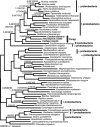
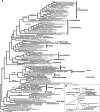
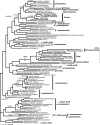

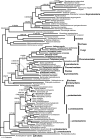
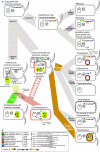
Similar articles
-
The pre-chorismate (shikimate) and quinate pathways in filamentous fungi: theoretical and practical aspects.J Gen Microbiol. 1993 Dec;139(12):2891-9. doi: 10.1099/00221287-139-12-2891. J Gen Microbiol. 1993. PMID: 8126417 Review. No abstract available.
-
Comparative analysis of the QUTR transcription repressor protein and the three C-terminal domains of the pentafunctional AROM enzyme.Biochem J. 1996 Feb 1;313 ( Pt 3)(Pt 3):941-50. doi: 10.1042/bj3130941. Biochem J. 1996. PMID: 8611179 Free PMC article.
-
In vivo overproduction of the pentafunctional arom polypeptide in Aspergillus nidulans affects metabolic flux in the quinate pathway.Mol Gen Genet. 1991 Jun;227(2):187-96. doi: 10.1007/BF00259670. Mol Gen Genet. 1991. PMID: 1648168
-
Characterization of the arom gene in Rhizoctonia solani, and transcription patterns under stable and induced hypovirulence conditions.Curr Genet. 2006 Mar;49(3):166-77. doi: 10.1007/s00294-005-0005-6. Epub 2006 Feb 15. Curr Genet. 2006. PMID: 16479402
-
A new scenario of plastid evolution: plastid primary endosymbiosis before the divergence of the "Plantae," emended.J Plant Res. 2005 Aug;118(4):247-55. doi: 10.1007/s10265-005-0219-1. Epub 2005 Jul 20. J Plant Res. 2005. PMID: 16032387 Review.
Cited by
-
Whole genome evaluation of horizontal transfers in the pathogenic fungus Aspergillus fumigatus.BMC Genomics. 2010 Mar 12;11:171. doi: 10.1186/1471-2164-11-171. BMC Genomics. 2010. PMID: 20226043 Free PMC article.
-
Horizontal gene transfer in plants.Funct Integr Genomics. 2014 Mar;14(1):23-9. doi: 10.1007/s10142-013-0345-0. Epub 2013 Oct 17. Funct Integr Genomics. 2014. PMID: 24132513 Review.
-
Unusual phenolic compounds contribute to ecophysiological performance in the purple-colored green alga zygogonium ericetorum (zygnematophyceae, streptophyta) from a high-alpine habitat.J Phycol. 2013 Aug;49(4):648-60. doi: 10.1111/jpy.12075. Epub 2013 May 23. J Phycol. 2013. PMID: 25810559 Free PMC article.
-
An aerobic eukaryotic parasite with functional mitochondria that likely lacks a mitochondrial genome.Sci Adv. 2019 Apr 24;5(4):eaav1110. doi: 10.1126/sciadv.aav1110. eCollection 2019 Apr. Sci Adv. 2019. PMID: 31032404 Free PMC article.
-
Engineering Escherichia coli to overproduce aromatic amino acids and derived compounds.Microb Cell Fact. 2014 Sep 9;13(1):126. doi: 10.1186/s12934-014-0126-z. Microb Cell Fact. 2014. PMID: 25200799 Free PMC article. Review.
References
-
- Andersson, J. O., S. W. Sarchfield, and A. J. Roger. 2005. Gene transfers from nanoarchaeota to an ancestor of diplomonads and parabasalids. Mol. Biol. Evol. 22:85-90. - PubMed
-
- Baldauf, S. L., A. J. Roger, I. Wenk-Siefert, and W. F. Doolittle. 2000. A kingdom-level phylogeny of eukaryotes based on combined protein data. Science 290:972-977. - PubMed
-
- Boucher, Y., C. J. Douady, R. T. Papke, D. A. Walsh, M. E. Boudreau, C. L. Nesbo, R. J. Case, and W. F. Doolittle. 2003. Lateral gene transfer and the origins of prokaryotic groups. Annu. Rev. Genet. 37:283-328. - PubMed
-
- Brinkman, F. S., J. L. Blanchard, A. Cherkasov, Y. Av-Gay, R. C. Brunham, R. C. Fernandez, B. B. Finlay, S. P. Otto, B. F. Ouellette, P. J. Keeling, A. M. Rose, R. E. Hancock, S. J. Jones, and H. Greberg. 2002. Evidence that plant-like genes in Chlamydia species reflect an ancestral relationship between Chlamydiaceae, cyanobacteria, and the chloroplast. Genome Res. 12:1159-1167. - PMC - PubMed
Publication types
MeSH terms
Substances
Grants and funding
LinkOut - more resources
Full Text Sources

